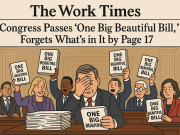The recent dismissal of the Commissioner of Labor Statistics amidst claims of manipulated employment data has sent ripples through the workforce community, policymakers, investors, and everyday Americans alike. In a moment when accurate, transparent labor statistics are more important than ever, this unprecedented move forces us to reflect deeply on the intersection between data integrity, economic confidence, and the future of work itself.
Employment figures are more than just numbers—they are the lifeblood of how we understand economic health and opportunity. For businesses, these metrics shape hiring decisions and strategic investments. For workers, they signify job security, wage potential, and life planning. For governments and markets, they influence policy-making, fiscal strategies, and financial flows. When questions arise about the veracity of these statistics, the very foundation of trust that sustains the broader labor ecosystem shakes.
The recent employment report delivered less encouraging news than anticipated: weak job growth that unsettled markets and stirred anxieties about the economic trajectory. In the aftermath, allegations surfaced pointing to manipulations that allegedly masked the true state of labor conditions. The subsequent replacement of the labor statistics chief becomes not merely a personnel change but a symbolic reckoning—a call to reassert the sacrosanct value of transparency and truth in labor reporting.
Transparency in labor data is not just about releasing numbers on time or with clarity—it’s about safeguarding the stories behind those numbers, the lives of millions who depend on accurate reflection of labor market realities. When trust erodes, the entire ecosystem—from individual workers planning their futures to policymakers designing interventions—faces heightened uncertainty. This event challenges us to reconsider how labor statistics are collected, validated, and communicated, emphasizing that data is only as valuable as the confidence it inspires.
The implications for the work community are profound. At a time when the nature of work is undergoing seismic shifts due to technology, globalization, and changing demographics, having a reliable compass for labor health is critical. Job growth figures inform more than economic reports—they inform worker empowerment initiatives, job retraining programs, and equitable growth strategies. The current turbulence underscores that behind each statistic lies a mandate: to honor the experiences, achievements, and struggles of the workforce with integrity.
Rebuilding this trust demands more than immediate remedies; it invites a broader conversation about accountability, transparency, and the role of data stewardship in shaping economic narratives. It reminds us that the labor market is not a detached abstraction but an arena marked by human aspirations, challenges, and resilience. As discussions continue around this issue, the work news community has a pivotal role to play—amplifying the call for open dialogue, advocating for reforms that ensure independence in data collection, and fostering public understanding of the critical importance of labor statistics.
In a world increasingly shaped by data-driven decision-making, this episode is a stark reminder that the integrity of our data shapes the integrity of our society. The future of work depends not only on innovation and opportunity but on an unshakeable foundation of trust and truth. The fireside moment created by these events can become a catalyst for renewed commitment—a chance to strengthen the pillars of transparency that will better serve workers, employers, and economies alike in the years to come.



























